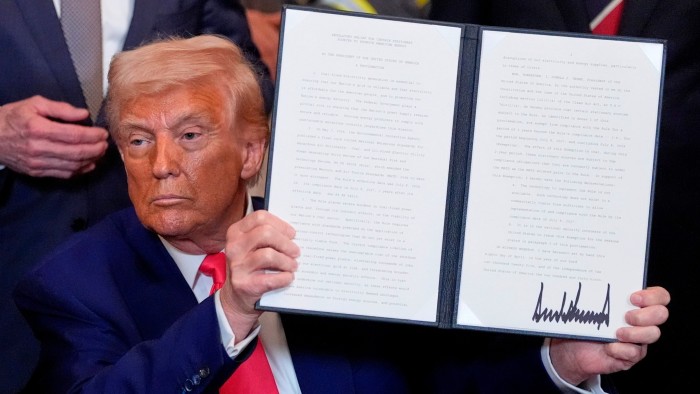Unlock the Editor’s Digest for free
Roula Khalaf, Editor of the FT, selects her favourite stories in this weekly newsletter.
As stock markets crashed amid the trade war, Scott Bessent, US Treasury secretary, tried to soothe frazzled investor nerves last weekend. “Most Americans in a 401(k) [retirement plan] have what’s called a 60/40 account . . . they are [only] down 5, 6 per cent on the year,” he declared on television.
Or, in plain English, since investment managers typically place 40 per cent of a portfolio in fixed income, falling equity prices should be partly offset by rising bond prices, since these typically move in opposite directions — at least according to financial textbooks.
No longer, however. Last week, bond prices did indeed surge as equities fell, seemingly because of rising recession fears. But this week they have plunged amid signs of poor demand at a Treasury auction.
That is highly unusual, as market analysts such as Larry McDonald point out: during stock market crashes in 2008, 2001, 1997 or 1987, bond prices rose. Indeed, this double whammy has only been seen recently during the Covid-19 panic.
If bond prices keep falling alongside equity prices it begs at least three questions: can markets tolerate this pain? Will the Federal Reserve intervene, as it did in 2020? And what is driving the bond market sell-off?
We may not get answers to the first two questions for several days. But clues around the third issue abound.
One (obvious) possibility is macroeconomic: investors are worrying about rising inflation, because of tariffs. Another is that some investment funds are probably dumping their most liquid assets to meet margin calls.
However another — more ominous — explanation is that volatility is erupting because hedge funds are being forced to unwind their so-called “basis trades”. This is a once-arcane strategy which involves making “leveraged bets, sometimes up to 100 times, with the goal of profiting from the convergence between the futures price and the bond price”, as Torsten Slok of Apollo private capital group puts it.
In recent years, such trades have exploded — albeit on a scale that is hard to track. Indeed, the explosion is so marked that three of the top five sources for non-US Treasury demand have been Luxembourg, the Cayman Islands and London — hedge fund centres.
The IMF recently (gu)estimated that these trades are worth $1tn, while Bloomberg analysis suggests that hedge funds hold 7 per cent of all Treasuries, seemingly more than dealer banks, and a sharp increase. Slok, for his part, says they total “$800bn and [are] an important part of the $2tn outstanding in prime brokerage balances.”
Either way, as bond markets tumble it seems likely that some funds are being forced to unwind trades, creating a whiplash effect similar to the one seen in 2020. And what makes this worse is that as market luminaries such as Bridgewater founder Ray Dalio issue dire warnings about America’s surging debt, chatter about putative future default risks is rising too.
The White House insists this is ridiculous. But traders know that when Trump was “just” a businessman, he repeatedly defaulted on his own debt. Some of the wilder policy ideas now floating around the White House include putative debt swaps, or quasi restructuring. Once-unimaginable scenarios are being imagined — and priced in.
Then there is the elephant in the bond room: the risk that the US-China trade war turns into a capital war, prompting Beijing (currently the second-biggest holder of Treasuries) to run from dollar assets.
There is scant proof of this happening — yet. But Beijing made one striking money move this week: it has let the renminbi weaken against the dollar, raising the prospect of currency wars. That makes it easier to imagine other scenarios. “Beware a trade war shift to a financial war,” wrote the head of FX research at Deutsche Bank.
Hence why Ed Yardeni, a macro strategist, has told clients that Trump’s team are now “playing with liquid nitro” with Treasuries. Maybe Bessent’s soothing words can calm investors down, or the Fed will intervene — or (hopefully) Trump himself will reverse course on tariffs and/or cut a deal with Japan, say, that could calm investors’ nerves. But until then, Yardeni’s analogy is correct; we could be sliding towards a financial crisis.




